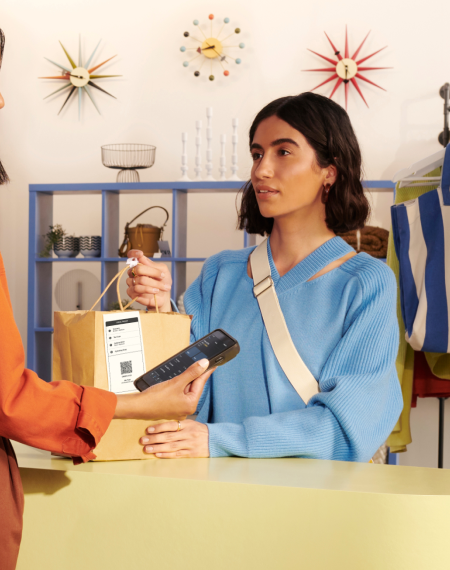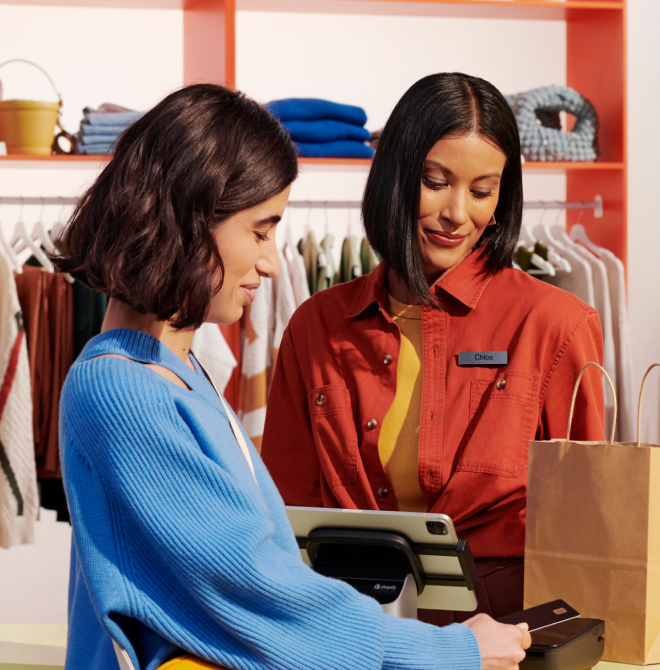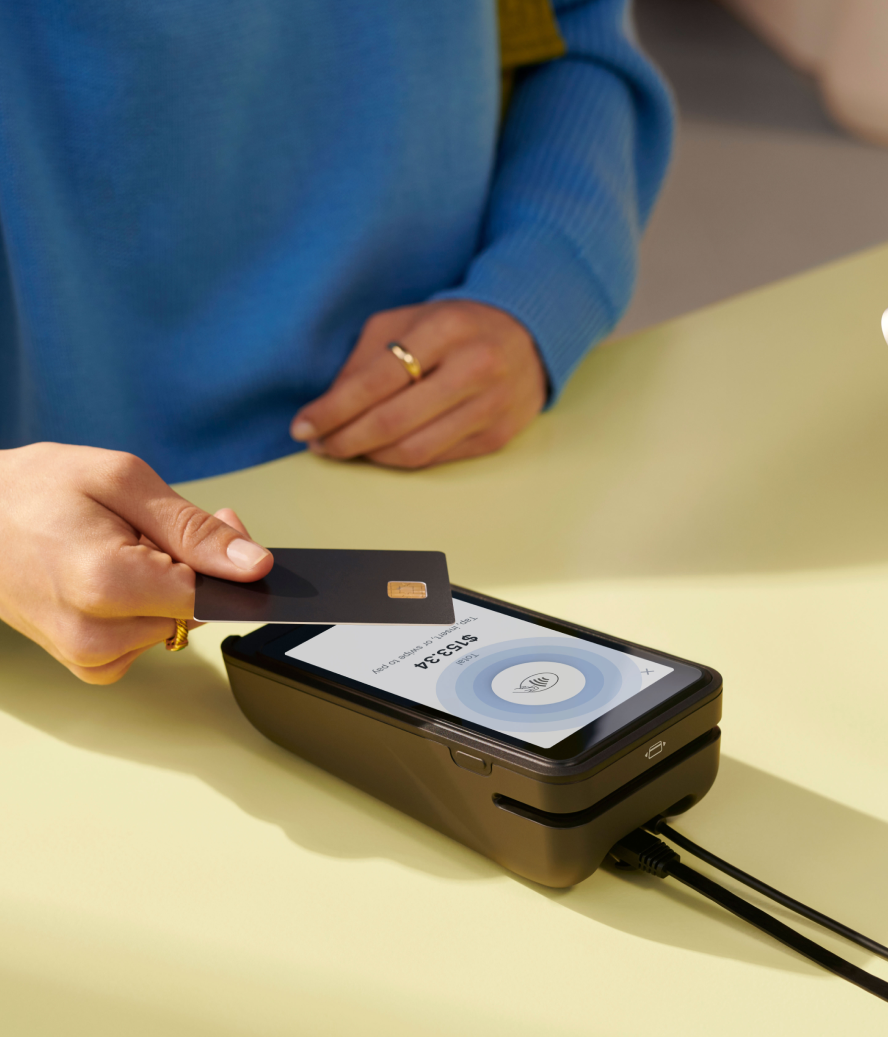Growing your business isn’t just a matter of acquiring new customers. Existing customers can be a lucrative source of repeat business and additional revenue—by some estimates, they generate 300% more revenue than first-time shoppers.
Tap into this potential by implementing a customer loyalty program—a rewards program for repeat customers who shop in-store, which you can easily manage through your point-of-sale (POS) system.
Here’s more on what POS loyalty programs are, the most popular types, and how to implement a customer loyalty strategy for your retail store.
What is a POS loyalty program?
A POS loyalty program is a customer loyalty program that’s integrated with your point-of-sale system and lets staff enroll shoppers so they can earn and redeem rewards.
POS loyalty programs can take many forms, including points-based systems, tiered programs, cash back, and exclusive offers or experiences. All are designed to incentivize and reward loyal customers for their repeat business.
Modern systems like Shopify POS consolidate all a customer’s loyalty points in their customer profile, saving time and effort that would otherwise be spent manually tracking or reconciling points earned when shopping online or at your store. This way, when a customer makes a purchase, your POS system automatically updates their profile with points or rewards earned.
💡Tip: Shopify POS doesn't include built-in loyalty features, but instead offers integration with third-party loyalty apps like Smile.io or Marsello from the Shopify App Store. These integrations boost customer retention and let shoppers collect and redeem points every time they shop with your brand online or in store.
Benefits of a POS loyalty program
Retaining existing customers is often more cost-effective than acquiring new ones. You can strengthen customer relationships and gain valuable insights into their behavior and preferences with a POS loyalty program.
Data and insights
The main benefit of using a POS system to run a loyalty program is customer data. A rewards program starts, runs, and ends with data, which can be stored in unified customer profiles—this includes purchase history, customer lifetime value, purchase frequency, favorite products, and more.
Loyalty programs also allow you to collect a customer’s contact information and add them to your email newsletter. This ensures shoppers are aware of upcoming product launches or promotions, and increases the likelihood they will buy from you again.
💡Tip: Customer data is the most valuable asset any modern retailer has. With Shopify, you have customer data management (CDM) by default. Anywhere a customer shops, any data you collect feeds back to one unified customer profile that becomes the foundation for personalized omnichannel experiences that modern customers demand.
Performance tracking
A POS loyalty system helps you track your program’s performance. For example, the total number of enrolled customers can teach you how well you’re driving signups, while the percentage of sales that come from loyal customers demonstrates how effective your loyalty program is at driving repeat sales. All of this helps connect your loyalty program back to what matters: customer lifetime value.
Higher order values
Customer loyalty programs not only help drive more repeat purchases but also gently incentivize shoppers to spend more than they may have initially planned.
If a shopper is just a few points away from earning a reward, they may choose to add more items to their order. If they have an exclusive discount on a higher-priced item, that may compel them to make a purchase. In either case, the loyalty program is helping you increase order values and generate more revenue.
4 popular types of POS loyalty programs
The sky’s the limit when it comes to the kinds of POS loyalty programs you can offer. Use your imagination to devise innovative ways to incentivize customers. Here are four popular loyalty programs you can incorporate into your POS solution to boost repeat visits.
Points-based POS loyalty program
Points-based POS loyalty programs are the most common. With this type of program, customers earn loyalty points that can be redeemed for perks and loyalty rewards, such as:
- Free samples
- Exclusive discounts
- Early access to new collections or sales
- Extended shopping hours
- A longer grace period for returns or exchanges
You can also get creative with how your customers earn points. Perhaps you offer two times the points as a birthday reward to encourage customers to buy your products on their special day or for a limited time.
For example, Milligram, a luxury stationery brand, relaunched its "Friends for Life" loyalty program using Yotpo after implementing Shopify Plus and Shopify POS. This integration allowed shoppers to collect and redeem loyalty points both online and in their physical stores without requiring manual integration.
“Finding the right POS system to integrate with our ecommerce system and loyalty program has been a big part of our journey improving as a physical retailer,” says founder Scott Druce.
It’s a move that paid off: since implementing its points-based loyalty system with Shopify, Milligram saw a 12% increase in average order value from omnichannel shoppers. The business also experienced 16% growth in in-store revenue.
Tiered POS loyalty program
A tiered POS loyalty program creates different levels for members based on a metric, usually the frequency or value of their purchases. The levels determine which perks customers can access—think of common tiering structures like Silver, Gold, Diamond, or Platinum. The higher the tier, the better the rewards.
Cashback POS loyalty program
With a cashback POS loyalty program, customers earn cash for making purchases. The money earned is usually a percentage of the total purchase amount. Although you can give real cash back, issuing store credit or gift cards for future purchases is more common.
Cashback can create a snowball effect: the more the customer shops, the more cash they earn, and the more incentive they have to return. You can also vary the reward percentage based on whether they pay full price or use a discount to drive sales of items with larger profit margins.
Subscription-based POS loyalty program
In subscription-based POS loyalty programs, members pay a recurring fee to get exclusive benefits, discounts, or perks. It’s a model that can create a constant revenue stream for your small business.
Ensure that members receive value from their subscription through exclusive benefits, such as early access to new product collections, or free, discounted, or expedited delivery, if you sell products online.
How to create a POS loyalty program
Now we know the types of rewards you can use to incentivize customer retention, let’s explore how to create a POS loyalty program for your store.
1. Choose a loyalty app
To implement a loyalty strategy, you’ll need to choose loyalty software that integrates with your POS system. The Shopify App Store is home to several apps that can add loyalty functionality to your integrated sales channels—POS included.
Popular loyalty apps for Shopify POS include:
- Marsello: Combines loyalty with email marketing and customer segmentation for a unified approach
- Smile.io: Known for its easy-to-use points, referral, and VIP programs with a focus on flexibility
- Yotpo: Offers integrated loyalty, reviews, and referrals with advanced marketing capabilities
- Growave: All-in-one marketing platform that includes loyalty, reviews, and social media integration
- Loloyal: Specialized in customizable, mobile-first loyalty experiences with offline capabilities
Clothing retailer Mizzen+Main, for example, integrates Yotpo with Shopify. The connection allows customers to earn rewards wherever they shop. In-store, retail employees can access a customer's online account via Shopify POS to view their loyalty points and apply credits to purchases.
“Our retail employees can go into a customer's account created online and see how many loyalty points they have and then apply their credits to their account," says Natalie Shaddick, the brand’s VP of ecommerce. “That would be very difficult to achieve if we didn’t have Shopify for both ecommerce and POS.”
2. Design your rewards program
Detail the following components in your loyalty policy to ensure everyone earns (and redeems) points the same way:
- Earning methods: How do customers earn their rewards? The simplest option is a dollar point equivalent. For example, loyal customers earn 3 points for every $1 they spend. You could also apply extra bonus points to specific scenarios, like products with high profit margins or in-store orders.
- Points value: What value do those loyalty points have? A one-to-one conversion is easiest to calculate, though you can apply accelerators to different reward tiers. VIP customers might get an extra 10% on their point value as a way to show your appreciation for their continued loyalty.
- Redemption eligibility: Are there any restrictions on how customers can redeem their rewards? A minimum spend threshold, like “spend $20 to redeem your points”, can increase basket size and ensure you’re still turning a profit on orders where loyalty rewards have been redeemed.
3. Teach retail staff how to manage rewards at checkout
For a POS loyalty program to work effectively, retail associates must know how to manage customer rewards when ringing up customer orders in-store. Your choice of POS influences how easy this is.
With Shopify POS, for example, you can create create POS UI extensions (a merchant-friendly way of saying "app buttons that appear on your checkout screen") to show a loyalty app tile on your Smart Grid. Store associates can ring up a customer's order as usual, then click the loyalty tile to retrieve their loyalty participation details. If the shopper wants to redeem a reward, associates can view those they're eligible for on the POS dashboard. Any points they redeem on their purchase automatically sync with their loyalty account.

4. Invite customers to join the POS loyalty program
Do a test order to confirm that your loyalty app integration is working as intended. Then, spread the word about your POS loyalty initiative and encourage customers to take part.
You could:
- Display signage in-store, perhaps using QR codes to divert customers to your loyalty signup page.
- Post about your new loyalty program on social media.
- Ask retail associates to invite new customers to join your loyalty program at checkout.
- Segment your VIP customers and send an email campaign to invite them to your loyalty program.
- Include loyalty program invitations in automated order confirmation or post-purchase emails.
- Send a personalized invitation to happy customers who’ve shared positive feedback (e.g. reviews).
💡Tip: Shopify’s native segmentation features use data from unified customer profiles to divide customers into segments based on qualities they share, such as VIP customers, those who live within a certain radius of your store, or have purchased specific products. Use these segments to send personalized email marketing campaigns that not only increase customer engagement but offer rewards that customers actually want.
Key POS loyalty app features
POS systems have different types of loyalty functionality included. Here are some key features to look for when choosing retail software that integrates with your POS system:
Unified sales data
To successfully manage a customer rewards program, you need an easy and effective way to collect, store, and analyze your customers’ sales data.
Look for a POS system that brings customer sales data together into a single place. This ensures you don’t have to reconcile figures between multiple tools or build spreadsheets to get the information you need.
Shopify's native unification of POS and ecommerce transactions also makes reporting on loyalty program effectiveness more accurate and actionable, giving you clear insights into how your loyalty program impacts customer behavior across all channels. In fact, research from a leading independent firm concluded that merchants using Shopify POS’ unified commerce functionality experience:
- 22% better total cost of ownership.
- 25% lower annual software subscription and maintenance costs.
- 8.9% uplift in their gross merchandise value.
Customization
Does your business need an out-of-the-box solution, or do you prefer to get into the nuts and bolts to create something with bespoke capabilities? Choose a loyalty app on the Shopify app store that meets your needs, whether you want a ready-to-use loyalty program or something that can be customized.
💡Tip: Use POS UI extensions to customize the Shopify POS Smart Grid and speed up checkout. Here’s a handy guide on how to do that with loyalty app partner Marsello.
Email marketing integrations
To drive more signups for your loyalty program, you’ll need to get the word out. Make sure your loyalty program integrates with your favorite email marketing tools, such as Shopify Email, Klaviyo, or Omnisend, so you can get more loyal customers to sign up.
Customer insights
A POS loyalty program is a treasure trove of data you can use to adjust your retail strategy. For example, you can see:
- At what point in the customer journey they’re most likely to enroll in the program
- Which incentives they’re most likely to redeem (e.g,. free shipping vs. percentage off)
- Where most of your customers sign up (e.g,. in-store, through purchase confirmation emails, etc.)
Let’s put that into practice and say you discover that most customers register for your loyalty program when they shop online. They might not realize that they can also earn and redeem points in-store. Add more in-store signage, and encourage store associates to invite customers to join the program at checkout, and monitor whether this influences participation.
Customer-friendly rewards dashboard
Speaking of signing up: your chosen loyalty app should make it easy for customers to not only enrol in the program, but also view and redeem any rewards they’ve earned.
Marsello, for example, features a customer profile that displays each shopper’s rewards tier, a reminder of how they can earn more points, and a virtual card for in-store scanning.

Omnichannel loyalty
If you sell online and in-store, your omnichannel loyalty app should have POS integrations that connect it with your ecommerce platform. This ensures loyalty program members can collect and redeem points when they shop online or at your store, rather than having separate accounts and balances for both.
Pet supplies retailer Tomlinson’s, for example, runs the Pet Club Annual Membership program using a custom discount app built with Shopify Functions. Customers can earn and redeem rewards both online and in-store, with automatic application of membership discounts on eligible orders.
Manage your POS loyalty program with Shopify
There’s more to operating a POS loyalty program than choosing an app and dishing out rewards. The program must be omnichannel and work everywhere you sell, while also helping you keep a handle on rewards so that your customer retention strategy doesn’t wind up sinking profits.
With Shopify and its surrounding ecosystem of loyalty apps, that job is made easier. There’s no patchy middleware or expensive integrations required to launch a POS omnichannel program. Everything’s built on one centralized business “brain” to give you ultimate control and flexibility in your retail operations—no matter where the sale takes place.
POS loyalty programs FAQ
What is a loyalty program in POS?
A loyalty program in POS is a customer retention strategy that rewards customers when they make repeat purchases. Customers earn rewards (sometimes known as points) when they checkout, which can be redeemed on future purchases.
What is the loyalty program app?
A loyalty program app is the software that helps retailers operate customer loyalty programs. They invite customers to join the program, track their purchases, and award eligible points whenever they buy.
What types of rewards are typically offered in a POS loyalty program?
Loyalty rewards can be anything, from discounts, free products, and add-ons, to relationship-building perks like sneak peeks into new collections, early access to sales, or an extended return or exchange period.
Can a POS loyalty program be customized to fit my business needs?
POS loyalty programs can be customized to fit your needs. For example, you might specify how many points customers earn on each purchase, the value of those points, and set criteria for how they can be redeemed.





